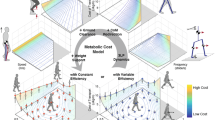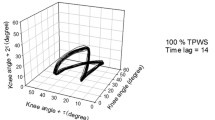Abstract
An analytical relationship between the basic variables of walking — step rate, step length, and metabolic energy expenditure — is formulated with the aid of data derived from the only two complete studies in the literature (Atzler and Herbst, 1927; Molen et al., 1972b). The relationship in its hyperbolic form indicates that for any given step length within the normal range of walking speeds (approximately up to 145 m/min) there is a unique step rate which requires minimal energy expenditure per unit distance traversed. Matching the given step length with any other step rate results in greater energy demand. As derived here, the condition of optimality requires that the step rate be directly proportional to the step length with a subject-dependent proportionality constant. Imposing this optimality constraint on the hyperbolic form yields an optimal pattern equation which virtually coincides, up to speeds of about 100 m/min, with an empirical equation of quadratic form, found by a number of investigators to adequately relate energy expenditure to speed under moderate walking conditions.
Similar content being viewed by others
References
Atzler, E., Herbst, R.: Arbeitsphysiologische Studien. III. Teil. Pflügers Arch. ges. Physiol. 215, 291–328 (1927)
Benedict, F. G., Murschhauser, H.: Energy transformations during horizontal walking. Carnegie Institution of Washington Pub. 231, pp. 52–60. Washington, D.C.: The Institution 1915
Bobbert, A. C.: Energy expenditure in level and grade walking. J. appl. Physiol. 15, 1015–1021 (1960)
Booyens, J., Keatinge, W. R.: The expenditure of energy by men and women walking. J. Physiol. (Lond.) 138, 165–171 (1957)
Corcoran, P. J., Brengelmann, G. L.: Oxygen uptake in normal and handicapped subjects, in relation to speed of walking beside velocity-controlled cart. Arch. phys. Med. 51, 78–87 (1970)
Cotes, J. E., Meade, F.: The energy expenditure and mechanical energy demand in walking. Ergonomics 3, 97–119 (1960)
Daniels, F., Vanderbie, J. H., Winsmann, F. R.: Energy cost of treadmill walking compared to road walking. Report No. 220, Environmental Protection Division, Natick QM Research and Development Laboratory, Lawrence, Mass. (1953)
Dean, G. A.: An analysis of the energy expenditure in level and grade walking. Ergonomics 8, 31–47 (1965)
Durnin, J. V. G. A., Mikulicic, V.: The influence of graded exercises on the oxygen consumption, pulmonary ventilation and heart rate of young and elderly men. Quart. J. exp. Physiol. 41, 442–452 (1956)
Lamoreux, L. W.: Kinematic measurements in the study of human walking. Bull. Prosthet. Res. BPR 10–15, 3–84 (1971)
Mahadeva, K., Passmore, R., Woolf, B.: Individual variations in the metabolic cost of standardized exercises: The effects of food, age, sex and race. J. Physiol. (Lond.) 121, 225–231 (1953)
Margaria, R.: Sulla fisiologia e specialmente sul consumo energetico della marcia e della corsa a varie velocita ed inclinazioni del terreno. Atti Accad. naz. Lincei, Mem. 7, 299–368 (1938)
Menier, D. R., Pugh, L. G. C. E.: The relation of oxygen intake and velocity of walking and running, in competition walkers. J. Physiol. (Lond.) 197, 717–721 (1968)
Molen, N. H., Rozendal, R. H.: Energy expenditure in normal test subjects walking on a motor-driven treadmill. Proc. kon. ned. Akad. Wet. C 70, 192–200 (1967)
Molen, N. H., Rozendal, R. H., Boon, W.: Fundamental characteristics of human gait in relation to sex and location. Proc. kon. ned. Akad. Wet. C 75, 215–223 (1972a)
Molen, N. H., Rozendal, R. H., Boon, W.: Graphic representation of the relationship between oxygen-consumption and characteristics of normal gait of the human male. Proc. kon. ned. Akad. Wet. C 75, 305–314 (1972b)
Müller, E. A., Hettinger, Th.: Arbeitsphysiologische Untersuchungen verschiedener Oberschenkel-Kunstbeine. Z. Orthop. 81, 525–545 (1952)
Ralston, H. J.: Energy-speed relation and optimal speed during level walking. Int. Z. angew. Physiol. 17, 277–283 (1958)
Reitemeyer, H.: Energieumsatz und Gangbild beim Gehen und Radfahren mit einem Unterschenkelkunstbein. Z. Orthop. 86, 571–582 (1955)
Author information
Authors and Affiliations
Rights and permissions
About this article
Cite this article
Zarrugh, M.Y., Todd, F.N. & Ralston, H.J. Optimization of energy expenditure during level walking. Europ. J. Appl. Physiol. 33, 293–306 (1974). https://doi.org/10.1007/BF00430237
Received:
Issue Date:
DOI: https://doi.org/10.1007/BF00430237




